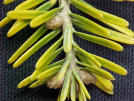Leaves
of deciduous plants and needles of evergreens occasionally
lose their normal green color. The key reason that plants turn
yellow is that they are not able to maintain adequate levels
of the green pigment,
chlorophyll. When this vital substance
is absent, yellow pigments that are also present take over and
the leaves or needles fade.
 Yellowing
of plant parts that are normally green is called chlorosis.
Affected parts are said to be chlorotic. Diseases, insects and
changes in the plant's environment cause leaves and needles to
become chlorotic. Determining which is to blame is not always
easy.
Yellowing
of plant parts that are normally green is called chlorosis.
Affected parts are said to be chlorotic. Diseases, insects and
changes in the plant's environment cause leaves and needles to
become chlorotic. Determining which is to blame is not always
easy.
Fungal diseases such as
apple scab or
anthracnose in
maples, oaks and
sycamores cause leaves to
yellow.
Needlecast diseases on pine, spruce and fir cause a
similar effect on needles. Viruses cause the loss of
chlorophyll in a mottled pattern on leaves and stems.
Sucking insects such as
aphids,
mealybugs
and scale remove nutrient laden sap from the plants
restricting their ability to make more chlorophyll. Spider
mite feeding produces a mottled pattern of yellowing similar
to a virus.
 Many
environmental factors cause a plant to yellow. The most basic
is a lack of adequate light. When plants become shaded by
other plants or by branches higher up on the same plant, the
chlorophyll fades away and the leaves yellow.
Many
environmental factors cause a plant to yellow. The most basic
is a lack of adequate light. When plants become shaded by
other plants or by branches higher up on the same plant, the
chlorophyll fades away and the leaves yellow.
Low light levels in the fall trigger the
normal development of fall color. Warm days and cool nights
then encourage the production of the pigment anthacyanin which
results in the bright red colors we all enjoy.
Nutrient deficiencies also cause chlorosis.
Nitrogen is a vital component of chlorophyll so inadequate
levels of this element make leaves turn yellow.
Iron
deficiencies cause chlorosis between the veins in leaves while
the veins themselves maintain their green color.
Too much or too little water can cause
yellowing. Under water stress, plants shut down internally and
cannot transport nutrients to the leaves. Chlorophyll
production can be affected causing loss of color.
Low temperatures can affect leaf color.
Under cool conditions, chemical reactions are slowed and, again, chlorophyll production may be
reduced.
reactions are slowed and, again, chlorophyll production may be
reduced.
Herbicides (weed killers) may also cause
yellowing. Some of these chemicals, including the widely used
Round-up, work by stopping
photosynthesis in the plant. Often,
they do this by blocking the production of chlorophyll.



